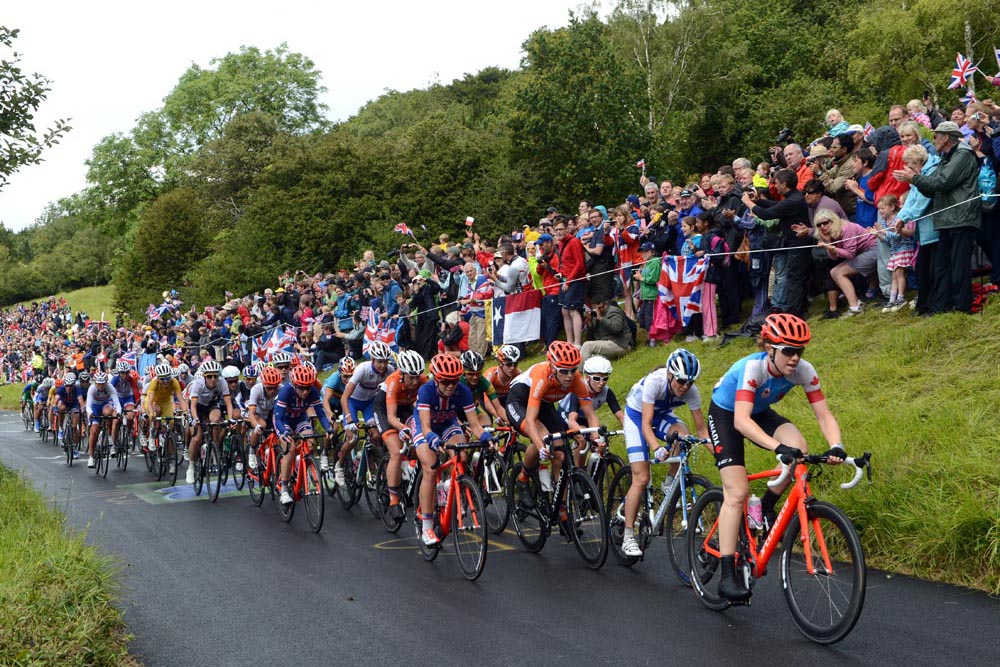Female pro peloton spends over twice as much time at highest intensities, research shows
Study looked at 3,691 race days over a four-year span

Clara Highes leads in the 2012 Women's Olympic Road Race. Watson

The stark differences between the men's and women's Olympic road race courses sparked controversy last week - but new research suggests that the shorter length of women's races means riders spend a much greater percentage of their racing time at higher intensity.
The research, published in the International Journal of Sports Physiology and Performance, looked at race data from 20 professional men, and 10 professional women over four consecutive years.
>>> Rider's respond to Toyko 2020 Olympic road race route
The study was led by sports scientist Dajo Sanders, who is also the head of scientific research at Team Sunweb - which has well supported squads across the genders.
In total, 616 women’s races and 3,024 men’s races were examined - with comparisons made between power output, training stress score (TSS), and rate of perceived exertion (RPE).
Within the files, the men's team managed 57 wins and 289 top ten finishes and the women 7 wins and 121 top 10's.
Intensity, average heart rate (and its percentage of the rider's maximum) were higher amongst the female racers.
The latest race content, interviews, features, reviews and expert buying guides, direct to your inbox!
Actual 'work completed' was similar between men and women, made possible by the men's races - which were much longer - featuring large chunks at lower heart rate.
The average men's race was 183 kilometres long - completed in 4 hours 45 minutes, vs women's 116 km ridden in 3 hours 14 minutes: these differences were observed as being 'large' and 'very large'.
Despite the discrepancy in distance, the men spent less than 10 per cent of their time in heart rate zone five - considered the highest band in this study - compared to women who spent more than 20 per cent of their time in the hurt box of the top zone.
The women's group had an average heart rate of 152 beats per minute (bpm): 79 per cent of their maximum, which was calculated at 185 bpm. The men's group had an average heart rate of 133 bmp, which is 69 per cent of the maximum calculated at 180 bpm.
The TSS differences between men's and women's races was minimal - women's averaged at 224 vs men at 255.
TSS effectively tells an athlete or a coach how much 'work' has been done - it's calculated by an algorithm that takes into account intensity and time spent riding.
The differences in average power, when calculated relative to weight, were considered 'small' by the researchers - women averaging between 2.8 w/kg to men's 3 w/kg.
Intensity Factor - which tells us how intense a ride is - told a similar story: women's was 0.83 vs men's 0.73 - a difference the researchers called 'large'.
Interestingly, the average RPE - the subjective scale that runs from 6 to 20, and assesses how hard riders thought a race was - sat at 15.4 for both men and women.
The researchers concluded: "Even though overall volume and absolute load are higher in men’s races, relative intensity and time spent at high intensity zones is higher in women’s races, despite a similar RPE."
The research was carried out largely to help coaches to understand the different demands of elite men's and women's races - but add an interesting insight into the discussion around the discrepancies between men's and women's courses.
Whilst many pro women say they'd be happy to race the distance asked of men, few ask for it.
What they're constantly calling for is for courses that will provide similar features which lend themselves to exciting racing.
Like the road race of the Rio Olympics in 2016: the same climbs, the same descents and the jagged backdrops of the mountains that make for brilliant photographs and TV viewing. Junk miles, many can take or leave - as could most TV viewers.
Michelle Arthurs-Brennan the Editor of Cycling Weekly website. An NCTJ qualified traditional journalist by trade, Michelle began her career working for local newspapers. She's worked within the cycling industry since 2012, and joined the Cycling Weekly team in 2017, having previously been Editor at Total Women's Cycling. Prior to welcoming her first daughter in 2022, Michelle raced on the road, track, and in time trials, and still rides as much as she can - albeit a fair proportion indoors, for now.
Michelle is on maternity leave from April 2025 until spring 2026.
